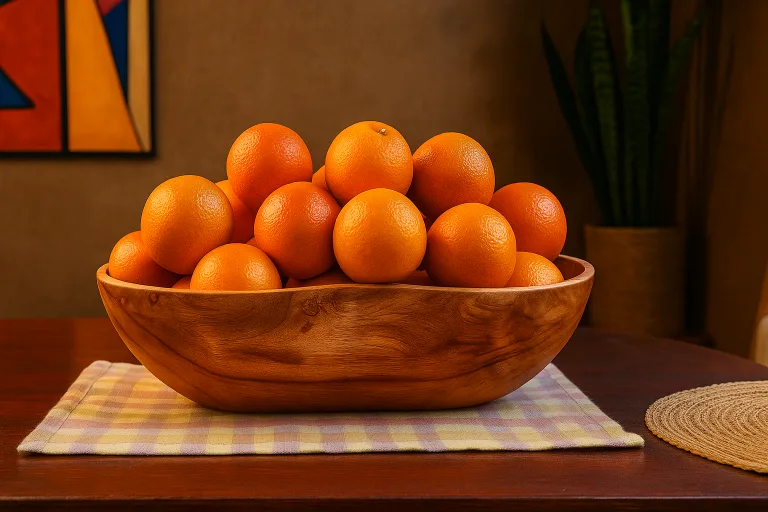Preserving Beauty, Function, and Tradition in Every Grain
Wooden salad bowls are more than just kitchenware =they are heirlooms in the making. Crafted from sustainably sourced hardwoods like olive wood, acacia, jacaranda or teak, these bowls bring natural warmth, texture, and timeless elegance to your dining table.
Fundamental Care: The Daily Ritual
Wood is a living material that breathes, expands, and contracts. Daily care is essential to prevent cracking, warping, and bacterial growth.
Do This:
- Hand wash immediately after each use with lukewarm water and a mild, phosphate-free dish soap. Avoid hot water—it can open the wood grain and accelerate drying.
- Use a soft sponge or cloth. Never use steel wool, harsh scrubbers, or the abrasive side of a sponge. These can create micro-scratches that trap food particles and moisture.
- Dry thoroughly by patting with a clean kitchen towel, then leave the bowl upside down on a drying rack in a well-ventilated area. Ensure it is completely dry before storing—any residual moisture invites mold and warping.
Never Do This:
- Do not place your bowl in a dishwasher or microwave. The heat and steam in dishwashers cause rapid expansion and contraction, leading to cracks. Microwaving can scorch or split the wood.
- Never soak the bowl or leave it submerged in water – even for a few minutes. Wood absorbs water like a sponge, and prolonged exposure weakens its structure.
- Avoid cooking oils such as olive, sunflower, coconut, or canola oil. Though they may seem natural, they oxidize over time, turning rancid and leaving a sticky film that is difficult to remove.
Deep Cleaning and Sanitizing: Restoring Freshness
Even with daily care, your bowl may develop stains, odors, or buildup—especially from oily dressings or acidic ingredients.
Natural Deep Clean for Sticky or Stained Bowls
- Mix 2 tablespoons of coarse salt with the juice of half a lemon to form a gritty paste. Gently scrub the interior in circular motions, following the grain.
- If lemons are unavailable, use baking soda mixed with a few drops of water as an alternative.
- Rinse thoroughly with cool water and dry immediately.
Optional Oven Method (Use with Caution)
Some woodworkers recommend gentle heat to release stubborn oils:
- Preheat your oven to 135°C (275°F).
- Place the empty, dry bowl upside down on the middle rack.
- Turn off the oven immediately after placing the bowl inside.
- Let it sit for 1–2 hours as the residual heat draws out trapped oils.
- Remove and cool completely before re-oiling.
⚠️ Use the oven method with caution – wood can crack if it dries too fast. An alternative is leaving the bowl in indirect sunlight for a few hours.
Sanitizing Safely
To kill bacteria without harsh chemicals:
- Mix 1 part white vinegar with 5 parts cool water.
- Wipe the bowl with this solution using a clean cloth.
- Let it sit for 5 – 10 minutes, then rinse and dry thoroughly.
- Never use bleach or ammonia – they can penetrate wood fibers and leave toxic residues.
Seasoning and Oiling: The Heart of Wooden Bowl Care
Seasoning nourishes wood and keeps it supple, water-resistant, and beautiful.
Seasoning a New Bowl
- Wash and dry the bowl thoroughly.
- Apply food-grade liquid paraffin generously to all surfaces – inside, outside, and rim = using a lint-free cloth.
- Let it soak for 4 – 6 hours, or overnight for best results.
- Wipe off excess oil.
- Repeat daily for 5 – 7 days, then weekly for the first month to build a protective layer.
Regular Oiling Schedule
- Oil once a month as routine maintenance.
- Re-oil whenever the wood looks dull, feels rough, or lightens in color.
- Always re-season after deep cleaning or sanitizing.
Why Liquid Paraffin Is Ideal -Especially in Kenya
Many guides mention “mineral oil,” but in Kenya, the most accessible option is liquid paraffin. This is a refined, pharmaceutical-grade oil that is colorless, odorless, tasteless, and non-reactive.
Benefits of Liquid Paraffin
- Does not go rancid (unlike plant-based oils).
- Food-safe when labeled BP/USP grade.
- Inert: will not react with acids, salts, or dressings.
- Affordable and widely available in Kenyan pharmacies.
Where to Buy in Kenya
- Look in the laxative or skincare section of pharmacies.
- Common labels: Paraffin Oil BP, Liquid Paraffin USP, or plain “White Oil.”
- Major chains like Goodlife, Wellness, and Medipharm, as well as local chemists, usually stock it.
Important Safety Check
- Ask for BP or USP grade liquid paraffin.
- Ensure it is plain (no fragrance, color, or additives).
- Avoid bottles labeled “for external use only” unless confirmed additive-free.
Storage Tip: Keep in a cool, dark cupboard. It has an indefinite shelf life and won’t degrade.
Oil Comparison: What Works – and What Doesn’t
| Oil Type | Recommendation | Reason |
|---|---|---|
| Liquid Paraffin (Mineral Oil) | ✅ Highly Recommended | Inert, food-safe, non-rancid, affordable, and widely available in Kenyan pharmacies. |
| Beeswax + Mineral Oil Blend | ✅ Excellent for Extra Protection | Adds a water-repellent sheen; great for frequently used bowls. Can be homemade (mix 1 part beeswax with 4 parts liquid paraffin). |
| Coconut, Olive, or Sunflower Oil | ❌ Avoid | Oxidize quickly, turn rancid, and create sticky films that trap bacteria. |
| Walnut or Flaxseed Oil | ⚠️ Not Recommended | They polymerize unpredictably, may spoil, and can cause allergic reactions. |
| Commercial “Wood Salad Bowl Finish” | ⚠️ Use with Caution | Some contain solvents or waxes not meant for food contact. Check for food-safety certification. |
Pro Tips for Long-Term Longevity
Storage Wisdom
- Store bowls upright or on their side – never stacked tightly.
- Keep in a cool, dry cupboard away from heat, moisture, and sunlight.
Smart Usage Practices
- Best for: salads, bread, fruit, nuts, and dry snacks.
- Avoid: soups, stews, or prolonged exposure to very acidic foods.
- Stain Alert: Beets, turmeric, and berries may stain temporarily—these fade with oiling.
Repairing Minor Damage
- Light scratches: Sand gently with 220 – 400 grit sandpaper, wipe clean, and re-oil.
- Small cracks: Oiling can slow drying and make cracks less visible, but it does not repair them. For larger splits, consult a woodcraft artisan.
A Bowl That Ages with Grace
With consistent care, your wooden salad bowl will not just survive—it will thrive. Over time, it will develop a rich, amber patina that tells the story of shared meals, family gatherings, and Kenyan hospitality.
Thanks to the ready availability of liquid paraffin in pharmacies, maintaining that legacy is simple and affordable.
Remember: Avoid over-washing, over-oiling, or experimenting with untested products. Stick to the basics – clean gently, dry thoroughly, and oil regularly – and your bowl will reward you with decades of service.
Your wooden bowl is not just a vessel, it is a piece of living history. Treat it with care, and it will grace your table for a lifetime.

